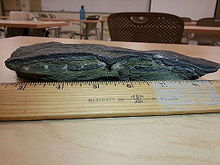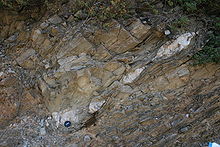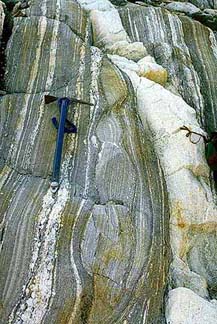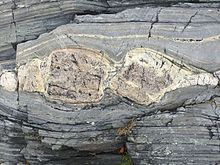Boudinage







Boudinageis a geological term for structures formed by extension, where a rigid tabular body such ashornfels,is stretched and deformed amidst lesscompetentsurroundings.[1]The competent bed begins to break up, forming sausage-shaped boudins. Boudinage is common and can occur at any scale, from microscopic to lithospheric, and can be found in allterranes.[2]In lithospheric-scale tectonics, boudinage of strong layers can signify large-scale creep transfer of rock matter.[2]The study of boudinage can also help provide insight into the forces involved in tectonic deformation of rocks and their strength.[2]
Boudinage can develop in two ways: planar fracturing into rectangular fragments or by necking or tapering into elongate depressions and swells.[3]Boudins are typical features of shearedveinsandshear zoneswhere, due to stretching along the shear foliation and shortening perpendicular to this, rigid bodies break up. This causes the resulting boudin to take a characteristic sausage or barrel shape. They can also form rectangular structures.Ductiledeformation conditions also encourage boudinage rather thanimbricatefracturing.Boudins can become separated by fractures or vein material; such zones of separation are known asboudin necks.[3]
In three dimensions, the boudinage may take the form of ribbon-like boudins or chocolate-tablet boudins, depending on the axis and isotropy of extension. They range in size from about 20 m thick to about 1 cm.[4]
Types
[edit]There are three different types of boudinage. These include no-slip boudinage, s-slip boudinage, and a-slip boudinage. No-slip boudinage occurs when there is no slip, resulting in a symmetrical structure. S-slip boudinage occurs when the boudin moves in opposition to the shear movement, whereas A-slip occurs when it moves with the direction of the shear. These types can be further classified into 5 different groups with relation to their general shape. These groups are drawn, torn, domino, gash and shearband boudins. In general, drawn and torn shapes form where there is a no-slip boudinage, domino and gash boudins by A-slip, and shearband boudins by S-slip boudinage.[5]
Etymology
[edit]Lohest (1909) coined the termboudinage,which is derived from the French word "boudin",meaning blood sausage. Boudins were first observed and described by Belgian geologists in the Collignon quarry nearBastognein theArdennes(Belgium).
References
[edit]- ^Fossen, H. (2010).Structural Geology.Cambridge University Press. p. 272.ISBN978-0-521-51664-8.
- ^abcMarques, Fernando O., Pedro D. Fonseca, Sarah Lechmann, Jean-Pierre Burg, Ana S. Marques, Alexandre J.M. Andrade, and Carlos Alves (2012)."Boudinage in Nature and Experiment."Tectonophysics 526-529, 88-96.
- ^abArslan, Arzu, Cees W. Passchier, and Daniel Koehn (2008)."Foliation Boudinage."Journal of Structural Geology, 30 (3), 291-309.
- ^"Boudinage." Encyclopædia Britannica (2010). Encyclopædia Britannica Online. 06 Oct. 2010 <http:// britannica /EBchecked/topic/75420/boudinage>.
- ^Goscombe, B.D.; Passchier C.W.; Hand M. (2004). "Boudinage classification: end-member boudin types and modified boudin structures".Journal of Structural Geology.26(4): 739–763.Bibcode:2004JSG....26..739G.doi:10.1016/j.jsg.2003.08.015.
Urai, J. L., Spaeth, G., van der Zee, W. & Hilgers, C. (2001).Evolution of Mullion (Boudin) structures in the Variscan of the Ardennes and Eifel.In: Jessell, M. J. (2001). General Contributions: (2001). Journal of the Virtual Explorer, 3, 1-16https://web.archive.org/web/20070908134406/http:// virtualexplorer.au/journal/2001/03/urai/
